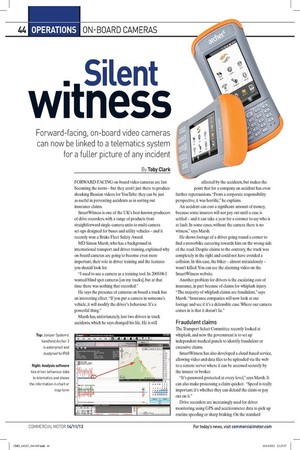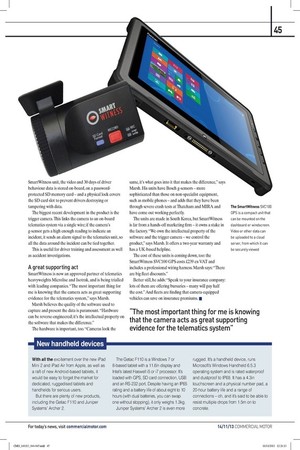. Silent witness
Page 36

Page 37

If you've noticed an error in this article please click here to report it so we can fix it.
Forward-facing, on-board video cameras can now be linked to a telematics system for a fuller picture of any incident By Toby Clark
FORWARD-FACING on-board video cameras are fast becoming the norm — but they aren't just there to produce shocking Russian videos for YouTube: they can be just as useful in preventing accidents as in sorting out insurance claims.
SmartWitness is one of the UK's best-known producers of drive recorders, with a range of products from straightforward single-camera units to multi-camera set-ups designed for buses and utility vehicles — and it recently won a Brake Fleet Safety Award.
MD Simon Marsh, who has a background in international transport and driver training, explained why on-board cameras are going to become even more important, their role in driver training and the features you should look for.
"I used to use a camera as a training tool. In 2005/06 I wanted blind spot cameras [on my trucks], but at that time there was nothing that recorded."
He says the presence of cameras on board a truck has an interesting effect. "If you put a camera in someone's vehicle, it will modify the driver's behaviour. It's a powerful thing." Marsh has, unfortunately, lost two drivers in truck accidents, which he says changed his life. He is still affected by the accidents, but makes the
point that for a company an accident has even further repercussions. "From a corporate responsibility perspective, it was horrific," he explains.
An accident can cost a significant amount of money, because some insurers will not pay out until a case is settled — and it can take a year for a coroner to say who is at fault. In some cases, without the camera there is no witness," says Marsh.
He shows footage of a driver going round a corner to find a motorbike careering towards him on the wrong side of the road. Despite claims to the contrary, the truck was completely in the right and could not have avoided a collision. In this case, the biker — almost miraculously — wasn't killed. You can see the alarming video on the SmartWitness website.
Another problem for drivers is the escalating cost of insurance, in part because of claims for whiplash injury. "The majority of whiplash claims are fraudulent," says Marsh. "Insurance companies will now look at our footage and see if it's a defensible case. Where our camera comes in is that it doesn't lie." Fraudulent claims
The Transport Select Committee recently looked at whiplash, and now the government is to set up independent medical panels to identify fraudulent or excessive claims.
SmartWitness has also developed a cloud-based service, allowing video and data files to be uploaded via the web to a remote server where it can be accessed securely by the insurer or broker.
"It's password-protected at every level," says Marsh. It can also make processing a claim quicker. "Speed is really important; it's whether they can defend the claim or pay out on it." Drive recorders are increasingly used for driver monitoring, using GPS and accelerometer data to pick up routine speeding or sharp braking. On the standard
SmartWitness unit, the video and 30 days of driver behaviour data is stored on-board, on a passwordprotected SD memory card — and a physical lock covers the SD card slot to prevent drivers destroying or tampering with data.
The biggest recent development in the product is the trigger camera. This links the camera to an on-board telematics system via a single wire; if the camera's g-sensor gets a high enough reading to indicate an incident, it sends an alarm signal to the telematics unit, so all the data around the incident can be tied together.
This is useful for driver training and assessment as well as accident investigations. A great supporting act
SmartWitness is now an approved partner of telematics heavyweights Microlise and Isotrak, and is being trialled with leading companies. "The most important thing for me is knowing that the camera acts as great supporting evidence for the telematics system," says Marsh.
Marsh believes the quality of the software used to capture and present the data is paramount. "Hardware can be reverse-engineered; it's the intellectual property on the software that makes the difference." The hardware is important, too. "Cameras look the
same, it's what goes into it that makes the difference," says Marsh. His units have Bosch g-sensors — more sophisticated than those on non-specialist equipment, such as mobile phones — and adds that they have been through severe crash tests at Thatcham and MIRA and have come out working perfectly.
The units are made in South Korea, but SmartWitness is far from a hands-off marketing firm — it owns a stake in the factory. "We own the intellectual property of the software and the trigger camera — we control the product," says Marsh. It offers a two-year warranty and has a UK-based helpline.
The cost of these units is coming down, too: the SmartWitness SVC100 GPS costs £239 ex-VAT and includes a professional wiring harness. Marsh says: "There are big fleet discounts." Better still, he adds: "Speak to your insurance company: lots of them are offering bursaries — many will pay half the cost." And fleets are finding that camera-equipped vehicles can save on insurance premiums. • The most important thing for me is knowing that the camera acts as great supporting evidence for the tetematics system"
With all the excitement over the new iPad Mini 2 and iPad Air from Apple, as well as a raft of new Android-based tablets, it would be easy to forget the market for dedicated, ruggedised tablets and handhelds for serious users.
But there are plenty of new products, including the Getac F110 and Juniper Systems' Archer 2.
The Getac F110 is a Windows 7 or 8-based tablet with a 11.6in display and Intel's latest Haswell i5 or i7 processor. It's loaded with GPS, SD card connection, USB and an RS-232 port. Despite having an IP65 rating and a battery life of about eight to 10 hours (with dual batteries, you can swap one without stopping), it only weighs 1.3kg. Juniper Systems' Archer 2 is even more
rugged. It's a handheld device, runs Microsoft's Windows Handheld 6.5.3 operating system and is rated waterproof and dustproof to IP68. It has a 4.3in touchscreen and a physical number pad, a 20-hour battery life and a range of connections — oh, and it's said to be able to resist multiple drops from 1.5m on to concrete.








































